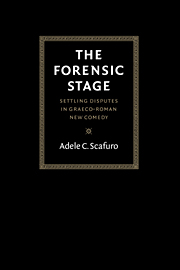Book contents
- Frontmatter
- Contents
- Preface
- Author's note on terminology, transliteration, translation, and texts
- List of abbreviations
- Introduction
- PART I PRE-TRIAL PLAYS
- PART II RECONCILIATION AND ITS RHETORIC
- PART III PLAYING ON THE BOUNDARIES OF THE LAW
- APPENDICES
- 1 Official arbitration in the Attic orators
- 2 Private arbitrations and reconciliations in Athens
- 3 Remedies for enslavement, kidnapping, and slave stealing in Athens and Rome
- 4 Controversial summonses in Rudens and Persa
- 5 Threats of lawsuits and self-help remedies in Graeco-Roman New Comedy
- 6 Ambiguous arbitri in Roman Comedy
- 7 Moikhos and moikheia
- Works cited
- General index
- Index locorum
3 - Remedies for enslavement, kidnapping, and slave stealing in Athens and Rome
Published online by Cambridge University Press: 03 March 2010
- Frontmatter
- Contents
- Preface
- Author's note on terminology, transliteration, translation, and texts
- List of abbreviations
- Introduction
- PART I PRE-TRIAL PLAYS
- PART II RECONCILIATION AND ITS RHETORIC
- PART III PLAYING ON THE BOUNDARIES OF THE LAW
- APPENDICES
- 1 Official arbitration in the Attic orators
- 2 Private arbitrations and reconciliations in Athens
- 3 Remedies for enslavement, kidnapping, and slave stealing in Athens and Rome
- 4 Controversial summonses in Rudens and Persa
- 5 Threats of lawsuits and self-help remedies in Graeco-Roman New Comedy
- 6 Ambiguous arbitri in Roman Comedy
- 7 Moikhos and moikheia
- Works cited
- General index
- Index locorum
Summary
ATHENS
Two Athenian procedures call for our attention first: aphairesis eis eleutherian and the dike exaireseōs. In aphairesis, a third party removes an alleged slave into freedom. This is an extra-judicial, self-help remedy. In the few references to aphairesis in the orators, the remedy (or alleged intention to use it) almost always occurs in response to the action of a self-proclaimed owner who attempts to seize (agein) his alleged slave; the usual sequence is therefore: seizure (agein) into slavery followed by removal into freedom (aphairesis eis eleutherian). With the exception of two problematic instances of aphaireseis (which might represent abuses of the remedy), the individual who is seized appears to have been living in freedom before seizure; nevertheless, it is likely that one could also be “removed into freedom” while living as a slave. If the alleged owner does not dispute the claim to freedom, then the aphairesis is successful and no further action need be taken. There is no instance of such an undisputed aphairesis in the orators. Instead, the alleged owner usually disputes the claim to freedom and initiates a dike against the third party rescuer which is called, apparently interchangeably, either a dike exaireseōs or dike aphaireseōs (an action for unlawful removal into freedom).
- Type
- Chapter
- Information
- The Forensic StageSettling Disputes in Graeco-Roman New Comedy, pp. 400 - 409Publisher: Cambridge University PressPrint publication year: 1997



